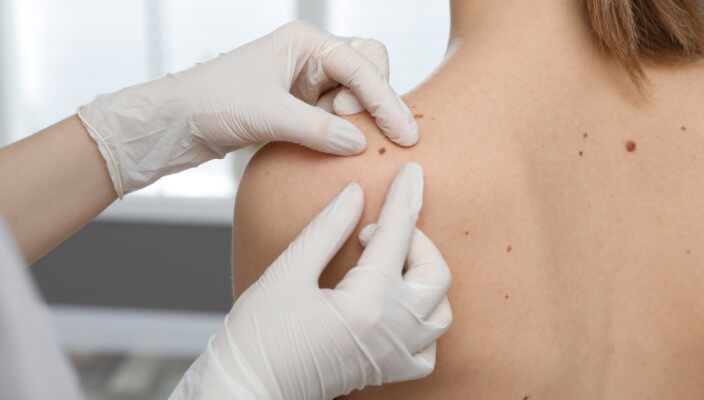Best Dermatology Tips for Treating Sunburn
A Summer Glow with Serious Consequences
 Kissed by the sun, or scorched by its UV rays? There’s a fine line between a natural summer glow and the aftermath of a red blotchy sunburn.
Kissed by the sun, or scorched by its UV rays? There’s a fine line between a natural summer glow and the aftermath of a red blotchy sunburn. Even if you’re applying SPF 30+ to your skin before heading to the lake, the longer you stay outside soaking up the sun, the better chance you have of developing a nasty burn, which can damage your skin, cause premature aging, and let’s not forget that excessive sun exposure can also lead to skin cancer.
Though there are many ways to prevent sunburn, it’s important to understand how to treat it when it happens, so you can help heal your skin and avoid further skin damage this summer.
5 Best Tips for Treating Sunburn
Tip #1: Seek Cover!
Notice a patch of red, itchy skin on your arms, shoulders, face, or legs? You may think you’re getting a nice, even tan, but the truth is, you’re exposing your skin to harmful UV rays. If you’re noticing your shoulders are red, cover them with a jacket or light sweater. Are your cheeks looking flushed? Wear a loose hat that shields your face.
Remember, applying SPF is important, but it can only protect you to an extent. As soon as you notice your color changing, cover up your skin and find a nice shaded area.
Tip #2: Start Treating Sunburn Immediately!
Just like you would for a common cold, if you start noticing early symptoms of a sunburn (e.g. pink or red skin, swelling, or itching), you’ll want to get indoors and start treating your skin to avoid further skin damage and irritation.
Tip #3: Apply a Cold Washcloth to Affected Area
For fast relief, apply a cool, damp washcloth to your burns. To help soothe severe burns, try applying wet tea bags to your skin: “The tannic acid in black tea is great for easing a sunburn on your face. Soak a few tea bags in cool water and apply them directly to your skin for a few minutes” (Allure).
Tip #4: Moisturize Your Skin
This tip comes from American Academy of Dermatology. They recommend using lotions that contain either aloe vera or soy to help treat sunburns. AAD also recommends staying away from any products containing petroleum, benzocaine, or lidocaine, as these ingredients can trap the heat in your skin and cause further irritation.
Note: Remember to check the labels on any of your aloe lotions. If your bottle is from a few summers back or is past its expiration date, it won’t provide the adequate strength you need to effectively treat your sunburn! The same goes for sunscreen. Always check their labels before use.
Tip #5: Allow Your Skin Time to Heal
Here’s another tip from AAD. While your skin is still recovering, remember to keep it covered with lightly woven fabrics. And if you’re using an ointment to help heal a burn or treat a blister, continue to use as directed. There’s plenty more sunshine and summer to enjoy, so remember to give your body the time it needs to heal before making another trip to the beach.
Sunscreen for All Skin Tones
Facts About Sunburn
- If your sunburn is causing you to experience any symptoms related to dizziness, high fever, nausea, or headache, get medical attention right away.
- A sunburn can typically appear within a few hours after sun exposure, but a patient may not realize the full extent of a burn for up to 24 hours or more (Mayo Clinic).
- A sunburn that develops into blisters is considered a second-degree sunburn. Remember to allow sun blisters to heal naturally to avoid skin damage (AAD).
- The sun’s UV rays can damage more than your skin. Too much exposure can also burn your corneas, so be sure to wear sunglasses to protect your eyes, too!
- Avoid UV exposure between 10 a.m.-4 p.m., as this is the time frame when the sun is strongest.
How Pinnacle Dermatology Can Help
For more tips on summer skincare, follow us on instagram at @PinnSkin. Schedule your appointment online to discuss your skincare needs, contact us today! We can suggest a personalized medical-grade skincare regimen, talk to you about sun safety, perform a Total Body Skin Exam, and discuss cosmetic service treatment options to help you regain confidence in your skin.
Featured Products for Sun Protection
Check your local office for current stock!
Check your local office for current stock!
Featured Blogs

- Skin Cancer
- General Dermatology
- Skin Exams
Your skin is your largest organ and its first line of defense. Learn more about why a skin exam should be a part of your wellness routine.
Read More
- Skin Cancer
- Sun Safety
The sun's ultraviolet (UV) radiation poses a significant risk. Discover ways to protect you and your loved ones from the sun and keep your skin healthy all year long.
Read More
- General Dermatology
- Sun Safety
- Chronic Skin Conditions
Debunking myths about actinic keratosis: Learn the truth about the causes, treatments, and prevention of this common sun-related skin condition.
Read More


